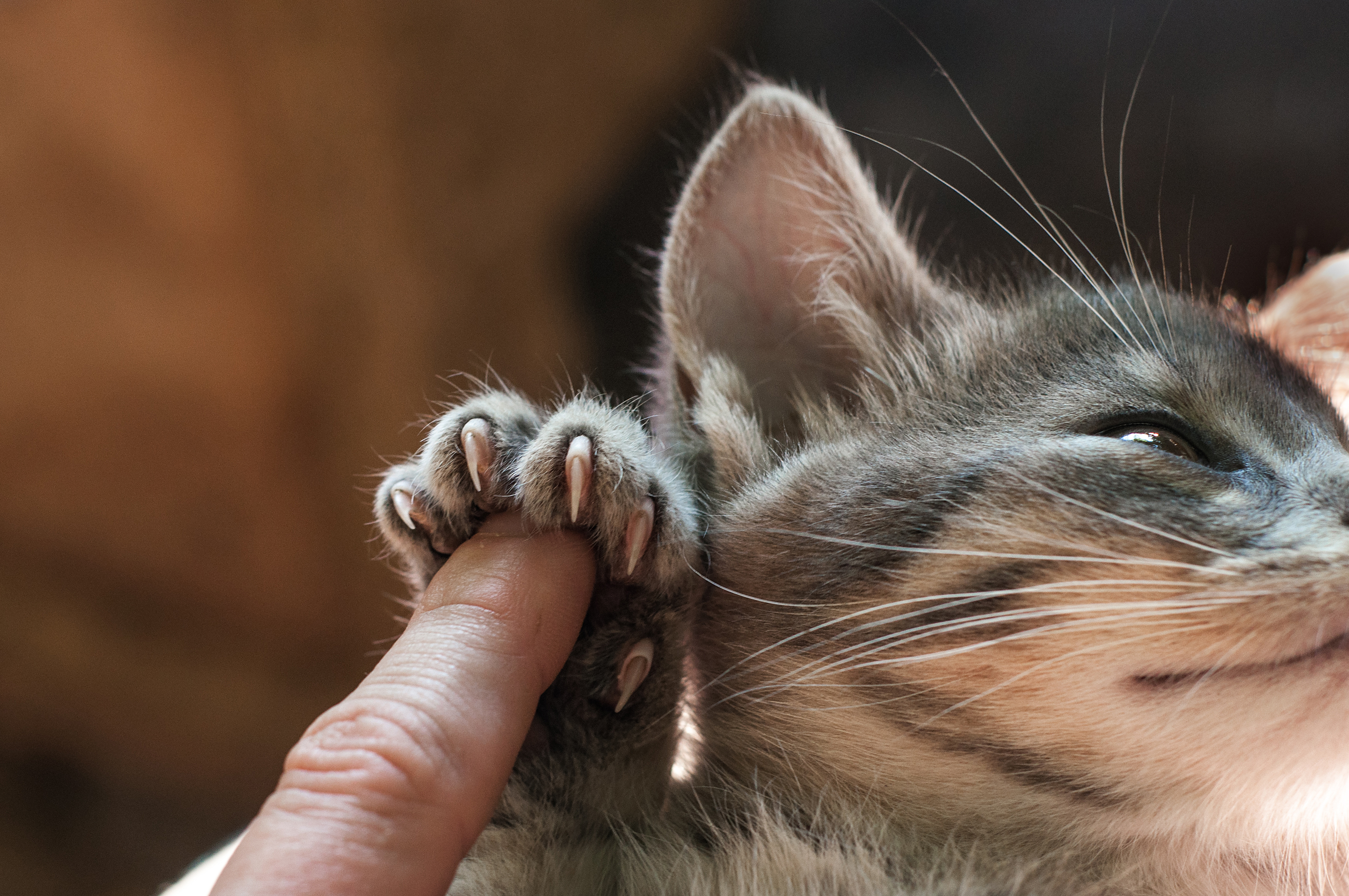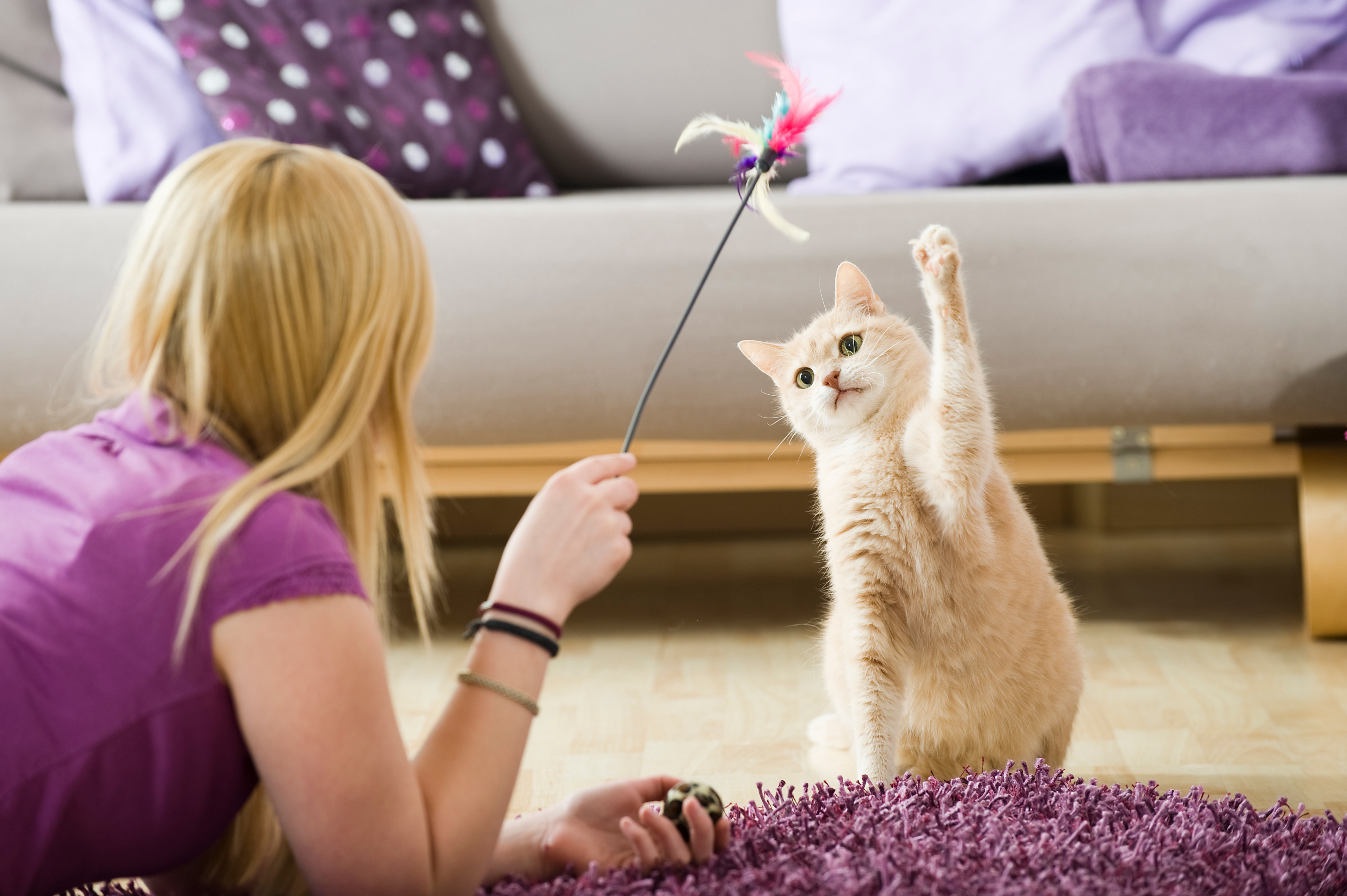Why Is It Important to Trim Your Cat’s Nails?
It’s important to trim your cat’s nails because overgrown and curved nails can grow into the footpad, which can cause pain and mobility issues for kitty. Clipping your cat’s nails also allows you to check on kitty’s peets and beans. Think of it not as a chore, but as another way to interact with your cat.
How Should I Cut My Cat’s Nails?
You want to be quick and snappy when you’re cutting the cat’s nails, taking care to clip the sharp tip and nothing else. We’ll get more into the technique in a bit, but you want to take the paw in your hand and gently press to extend the claw fully so you can snip the tip.
If you’re a new cat owner or preparing to adopt a kitten , it’s a good idea to look into cat nail clippers and other items to have on hand when bringing kitty into your home.
How Often Should You Trim Your Cat’s Nails?
You should trim your cat’s nails as often as every week, and at least once every 3 weeks. Getting into a consistent routine of clipping your cat’s nails will help kitty get comfortable with the process and make it far easier to keep kitty’s nails under control.
So, you know the importance of trimming and how often to trim. Now, how do you put it into practice?
Tips for How to Trim Your Cat’s Nails

Knowing how to clip kitty’s long claws and what to look for when doing so is important. It’s also important to know how to interact with your cat in order to keep them calm while rewarding them for their patience and behavior after a successful trim. Here are some tips for how to trim your cat’s nails.
1. Start ‘Em Young
One of the best ways to make the nail-trimming process easier is to start earlier. Grooming tools, like clippers, are must-have checklist items for new cat owners. Having those on hand is essential for getting into an immediate rhythm when it comes to clipping your new kitten’s nails.
The same goes for adopted kittens, too. While cats adopted from shelters are typically already litter-trained, you want to help them get used to their litter and environment in their new home . Such is the case with trimming cats' nails! Getting into a routine will only make kitty feel more comfortable when you trim their nails going forward.
2. Make Sure Kitty Feels Comfortable
Don’t expect your cat to simply saunter over to you as you approach them with a clipper in your hand. After they’ve eaten their food can be a good time to intercept kitty for a trim. Stay calm and reassuring and try to be somewhere they feel safe and secure. Many cats need to be held firmly and gently during the trimming process. As such, it’s probably a good idea to cradle them in the crook of your arm or put them up on a table before you examine their beans and begin to clip. Regardless of the setup you choose, address one paw at a time.
If you have someone helping you when you trim your cat’s nails for the first time, ask if they can scratch kitty’s favorite spot, hold up a treat or a toy as a distraction, or help kitty feel more secure.
3. Use the Proper Clipping Technique
Once you’ve established a good spot to place your cat, you need to get the claw into position so you can safely trim your cat’s nails.
Take one paw in your hand—it’s usually easier to start with one of the front paws – which are also the ones cats use when scratching sofas or around the home—then use your thumb and index finger on the top and bottom of the paw, respectively. Gently press down on the joint just behind the claw. The claw should extend so you can quickly cut the sharp tip. Make sure to hold your clippers at a 45-degree angle when snipping the nail.
Take particular care to avoid the pink part of the nail, also known as “the quick.” This area contains many blood vessels and nerve endings and is especially sensitive. Cutting too far could result in bleeding and pain for your cat.
What to Do if You Cut Your Cat’s Nails Too Far
If you accidentally cut “the quick” or your cat begins to bleed after you’ve begun trimming, stay calm. You can try applying a small amount of pressure to the tip of the paw. If your cat has had enough, however, you should stop and allow kitty a breather.
Check in later to make sure the bleeding has stopped and try not to worry too much. Cats can also “break a nail” running around the house careening corners or if they get a claw stuck in something. So, while kitty won’t be happy about a trim that cut too close to the quick, they know how to clean their paw and their claws grow quickly. And kitty will forgive you even faster!
4. Don’t Force the Issue

Unless you have an extremely mild-mannered cat or kitten, you might not be able to cut all 10 nails in one trimming session. Your cat may get fussy after you cut 2 or 3 nails. That’s perfectly fine! Let them go and see whether you can trim the rest of the nails across several short sessions
If you continue to feel uncomfortable figuring out how to trim your cat’s nails, you can always consult a veterinarian or vet tech for assistance. They get lots of practice and can take care of the nail trim quickly!
5. Reward Your Cat!
You want your cat to think of the nail-trimming process as something normal, rather than one that induces anxiety. Thus, it’s a great idea to reward your cat after clipping, whether you only manage to get 2 or all 10 nails.
Consider giving your cat a treat after a trim. Better yet, schedule some play time around clippings and break out their favorite toy so they learn to associate positive things with getting their nails cut.
Should You Declaw Your Cat?
You should never declaw your furbaby as an alternative to trimming their nails. Declawing can cause paw pain, back pain, infection, tissue death and more. Moreover, improperly removed claws can regrow, which may result in nerve damage and bone spurs. Cats need their claws to help with balance, walking, and climbing. Always consult your veterinarian about how you can approach trimming your cat’s nails or providing proper places for them to scratch before resorting to declawing.
Can You Clip Cat Nails with Human Clippers?
It is acceptable to use human nail clippers to trim your cat’s nails but be sure the blade has not dulled and is sharp enough so it can successfully cut the tip. Otherwise, using a dulled blade may cause the nail to splinter, rather than cut clean off.
You might use special modified scissors designed for pets that can help keep the claw in place with a sliding “guillotine” blade. But if your own nail clipper is sharp enough to get the job done and you feel comfortable, go ahead!
Will Your Cat Scratch Even More If You Trim Their Nails?
Trimming your cat’s nails will not lead to any more or less scratching behavior. However, by trimming kitty’s claws, you help reduce possible damage to household items like upholstered furniture or curtains. Scratching is in a cat’s nature, which is why having a scratching pad for them to play with is always a good idea.
Trimmed nails can also make it more comfortable for you when kitty is on your lap and then decides to get up quickly, or when they’re playing with your toes under the sheets. Cutting the sharp tip off those peet-needles can help make cuddly time more fun.
ARM & HAMMER™ Cat Litters are Soft on the Peets
Trimming your cat’s nails is one way to help keep them healthy and mobile. Ensuring they have a litter they enjoy is another way to help them stay happy and comfy in your home! ARM & HAMMER™ litters have soft, sandy particles that feel great on kitty paws, before or after a nail trim. Try:
- ARM & HAMMER™ Multi-Cat Strength Clumping Litter helps eliminate the toughest odors, even in multi-cat homes!
- ARM & HAMMER™ Super Scoop™ Clumping Litter, Fragrance Free is 99 percent dust free and designed for fragrance-sensitive cats and owners.
- ARM & HAMMER™ Forever Fresh Clumping Litter has a lavender scent with essential oils, plus baking soda to help neutralize odors.


